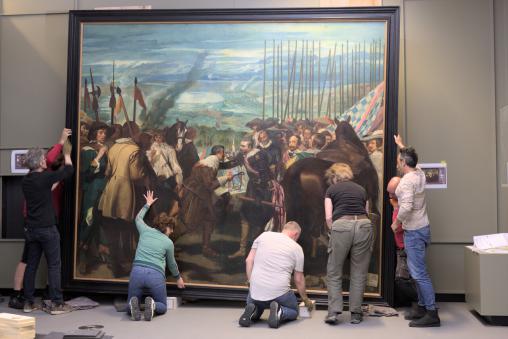Witte Rook Residency - Las Lanzas in Breda

Witte Rook has invited the artist duo Iratxe Jaio and Klaas van Gorkum for a residency project. Their working period and artistic research delve deeper into the shared Spanish and Dutch history—particularly that of Breda and Madrid—by placing it in a contemporary context. The starting point for the project Las Lanzas is the presence of various copies of the famous painting La rendición de Breda by Diego Velázquez in Breda, which depicts the surrender of Breda during the Eighty Years War with Spain.
The painting La rendición de Breda depicts the surrender of Breda and is housed in the Prado Museum in Madrid. It is a significant work in Velázquez’s oeuvre and a prominent part of the Prado’s collection, permanently on display. When looking at the composition itself, the painting’s political role is evident: it portrays an honourable exchange between rulers, reinforced by a symbolic gesture—the handing over of Breda’s city key. The arrangement is highly theatrical, with no traces of battle, as the work is not based on an actual historical account but rather on a stage play. The painting is considered a key work in the canon of Spanish visual art, glorifying the Spanish empire at a time when it was already in decline.
The copy hanging in Breda’s City Hall was created by Fernando Coll in 1931 and purchased in honour of Breda’s mayor, Van Sonsbeek. It is prominently displayed in the hall and often serves as a backdrop for photographs of special occasions, without much regard for the painting’s actual meaning.
The other copy, an older version by Kees Maks from 1903, was previously exhibited in the café of the Stedelijk Museum Breda. However, following a recent renovation and a shift in focus within the historical exhibition, it has now returned to the main gallery. Once again, a certain glorification of past grandeur comes into play, in service of a renewed attention to the history of the royal Nassau family.
The oldest copy can be found at the Breda Castle, home of the Dutch Military Academy. It dates from 1872 and was painted by the French artist André-Julien Prévost.
During a working period starting in September 2023, artists Iratxe Jaio and Klaas van Gorkum will conduct comparative research into the role each copy plays as a cultural artefact. Their approach is based on the idea that context is crucial in determining a work of art’s meaning. Although the images appear nearly identical, they serve vastly different functions. By engaging with the various communities that have built a relationship with these paintings, new interpretations emerge.
Through research, video documentation, and staged interventions, the artists aim to explore the connections between the different copies, with a particular focus on the events and interactions that take place around them. What recurring patterns can be identified, and in what ways do they differ? What can this reveal about the relationship between contemporary audiences and art, or history itself?
The final presentation of this project will take place in June and July 2025 at the StadsGalerij in Breda. In 2024, part of the project, A Hundred Weddings before the Surrender of Breda, was presented during the Breda Month of History, and Iratxe Jaio gave a lecture on the research at the Stedelijk Museum Breda.
The project of the artists is made possible by the Municipality of Breda, the Mondriaan Fund, The Dutch Embassy in Madrid, Instituto Cervantes in Utrecht, and thanks to the collaboration of Stedelijk Museum Breda, Kasteel Helmond, Kasteel Breda and the Prado Museum in Madrid.




